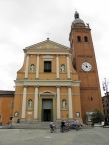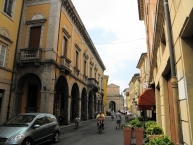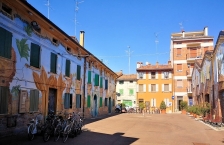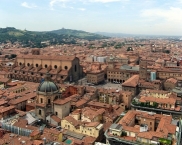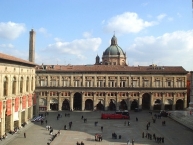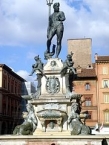Radtour Teilstrecke Eurovelo/Sonnenroute - von Bologna nach Rom -
Reisebericht
Aktionen
![]()
Bitte warten - Kartendaten werden geladen
Erstellt am 23.05.2016,
zuletzt geändert von ihmuc am 12.06.2016
Aktionen
Strecken-Merkmale
geplant
gefahren
Gesamtlänge in km
727
415
Gesamthöhenmeter Aufstieg
0
4.954
Durchschn. Steigung Aufstieg %
-
1,19
Gesamthöhenmeter Abstieg
0
5.074
Informationen zu Rechten an den GPS-Track-Daten | |
|---|---|
Rechte-Inhaber | ihmuc & biroto-Contributors |
Rechte-Ausprägung / Lizenz | cc0: Public Domain keine Rechte vorbehalten |
Link zur Rechtebeschreibung | |
gpx-Datei übernommen aus | |
gpx-Datei hochgeladen | durch ihmuc am 23.05.2016
|
Gesamtzahl Trackpoints
10.783
3.085
Trackpoint-Dichte per km
15
7
Endorte
Start
Bastiglia, Emilia-Romagna, IT (0 m NHN)
Ziel
Minturno, Lazio, IT (0 m NHN)
Charakter
Abwechslungreiche Strecke - oft an oder auf oder neben Nebenstraßen oder auch mal an der Autobahn entlang - anspruchsvoll durch steile Anstiege (Appenin, aber auch im weiteren Verlauf immer wieder).
Streckenbeschilderung recht rudimentär vorhanden (folgt teilweise einem italienischen Fernradweg ..).
Ohne GPS sehr schwierig.
Informationen zu Urheber-Rechten | |
|---|---|
Rechte-Ausprägung / Lizenz | by-sa: CREATIVE COMMONS Namensnennung, Weitergabe unter gleichen Bedingungen |
Link zur Rechtebeschreibung | |
übernommen / bearbeitet am | 23.05.2016
|
übernommen / bearbeitet durch |
|
Landschaft
Wunderbare italienische Landschaften.
Bergiger Appenin.
Immer wieder auf Höhenrücken entlang oder an Flussläufen.
Toskana ... was muss man mehr beschreiben ;-)
Informationen zu Urheber-Rechten | |
|---|---|
Rechte-Ausprägung / Lizenz | by-sa: CREATIVE COMMONS Namensnennung, Weitergabe unter gleichen Bedingungen |
Link zur Rechtebeschreibung | |
übernommen / bearbeitet am | 23.05.2016
|
übernommen / bearbeitet durch |
|
An- und Abreise
Schwierig!
Zugfahren in Italien - eine eigene Geschichte!
Wir hatten das Auto bei einem Freund in Brixen geparkt - wollten mit gebuchtem Ticket nach Bologna - der österreichische Schaffner hat uns wieder hinausgeworfen, obwohl wir bereits im Zug waren - es wären nur 2 Stellplätze für Fahrräder im Zug vorhanden und diese seien besetzt - im Vorhinein zu reservieren gingen die Plätze jedoch auch nicht, so hatten wir nur ein Ticket für uns Beide - Ticket verfallen! :(((
Gut geht es mit Regionalzügen - zwar langsamer - evtl mit Umstieg - aber mit Fahrrad in der Regel (und wenn nicht gerade Stoßzeiten oder Ferien) kein Problem - man muss allerdings ganz genau recherchieren!
Von Rom dann zurück mit dem Schnellzug - extra Gepäcktasche für das Fahrrad gekauft und nach Rom geschickt (Unterkunft vorgebucht und dorthin geschickt); am Bahnhof dann die Räder zerlegt, da sie teilweise nicht recht in die Tasche passten; mit Gepäcktaschen und Radtaschen dann in den engen Zug .... kein Spaß ... hat aber wenigstens funktioniert ;-)
Bemerkungen
Eine feine Tour durch das schöne Italien - durch die oft nicht einfache Wegfindung und Streckenführung - ein wenig abenteuerlich :-)
Unterkunft zu finden ist in der Zwischensaison manchmal ein wenig schwierig - und in der Hauptsaison wohl auch ...
VORSICHT!: die Original-Tour wurde von Süd nach Nord aufgezeichnet - und so fährt man teilweise in Einbahnstraßen verkehrt herum rein!!! Ein Mal ist es so, dass diese dann mit Mauern begrenzt ist und der Gegenverkehr sehr schnell anrollt - unbedingt Alternativen suchen!
Etappen
Fahrradfreundliche Unterkünfte, Sehenswertes und Infrastruktur
Name u. Anschrift
Breite / Länge
Tel.
Fax.
Mobile
Art d. Unterkunft
Radler-freund-lichkeit
Strecken-km
km zur Strecke
Höhe
20 km
1,8 km
26 m
24 km
4,1 km
20 m
Informationen zu Urheber-Rechten | |
|---|---|
Rechte-Inhaber | |
Rechte-Ausprägung / Lizenz | by-sa: CREATIVE COMMONS Namensnennung, Weitergabe unter gleichen Bedingungen |
Link zur Rechtebeschreibung | |
Bild übernommen aus | |
Bild hochgeladen | durch biroto-Redaktion am 28.12.2022
|
Informationen zu Urheber-Rechten | |
|---|---|
Rechte-Inhaber | |
Rechte-Ausprägung / Lizenz | by-sa: CREATIVE COMMONS Namensnennung, Weitergabe unter gleichen Bedingungen |
Link zur Rechtebeschreibung | |
Bild übernommen aus | |
Bild hochgeladen | durch biroto-Redaktion am 28.12.2022
|
Informationen zu Urheber-Rechten | |
|---|---|
Rechte-Inhaber | https://commons.wikimedia.org/w/index.php?title=User:Lary3lary |
Rechte-Ausprägung / Lizenz | by-sa: CREATIVE COMMONS Namensnennung, Weitergabe unter gleichen Bedingungen |
Link zur Rechtebeschreibung | |
Bild übernommen aus | |
Bild hochgeladen | durch biroto-Redaktion am 28.12.2022
|
San Giovanni in Persiceto ist eine italienische Gemeinde mit 28.254 Einwohnern (Stand 2019).
Sehenswürdigkeiten
Religiöse Architektur
- ⊙Ehemaliger Klosterkomplex von San Francesco
- ⊙Die Stiftskirche San Giovanni Battista, begonnen 1671 [19], bewahrt wichtige Gemälde von Bologneser Malern, darunter Guercino, Francesco Albani, Ubaldo Gandolfi, Alessandro Guardassoni. Darüber hinaus beherbergt der Glockenturm die älteste Glocke in der Gegend von Bologna, die 1318 gegossen wurde.
- ⊙Chiesa della Beata Vergine della Cintura. Es wurde auf einem ursprünglichen Gebäude aus dem Jahr 1547 erbaut und im 18. Jahrhundert von Alfonso Torreggiani renoviert.
- ⊙Kirche Sant'Apollinare, im 15. Jahrhundert im spätgotischen Stil umgebaut.
- ⊙Kirche Santissimo Crocifisso, erbaut im 15. Jahrhundert.
Zivile Architektur
- ⊙Der 1734 vom Architekten Giuseppe Civoli entworfene Palazzo San Salvatore wurde zwischen 1737 und 1768 erbaut. Seit 1959 beherbergt er die Stadtbibliothek von Giulio Cesare Croce.
- ⊙Casa dell'Abate oder Palazzaccio, erbaut im 12. Jahrhundert als Residenz des für die Erhebung des Zehnten für die Abtei von Nonantola zuständigen Bevollmächtigten.
- ⊙Rathaus (Palazzo comunale)
- ⊙Porta Garibaldi, erbaut 1830.
- ⊙Porta Vittoria, erbaut 1781 nach einem Entwurf von Giovanni Giacomo Dotti.
- ⊙Das von Giuseppe Tubertini entworfene Stadttheater (Teatro comunale) wurde 1790 erbaut.
Plätze
- ⊙Piazzetta Betlemme. Die Bemalung der Häuser am Platz wurde 1982 für eine Sommerveranstaltung, die dem komischen Kino gewidmet war, von Gino Pellegrini entworfen. 1990 neu mit den jetzigen Motiven bemalt.
Informationen zu Urheber-Rechten | |
|---|---|
Rechte-Ausprägung / Lizenz | by-sa: CREATIVE COMMONS Namensnennung, Weitergabe unter gleichen Bedingungen |
Link zur Rechtebeschreibung | |
Text(e) übernommen von: |
Contributori di Wikipedia, 'San Giovanni in Persiceto', Wikipedia, L'enciclopedia libera, 27 dicembre 2022, 10:45 UTC, https://it.wikipedia.org/wiki/San_Giovanni_in_Persiceto |
übernommen / bearbeitet am | 28.12.2022
|
übernommen / bearbeitet durch |
|
47 km
0,5 km
76 m
Informationen zu Urheber-Rechten | |
|---|---|
Rechte-Inhaber | |
Rechte-Ausprägung / Lizenz | by-sa: CREATIVE COMMONS Namensnennung, Weitergabe unter gleichen Bedingungen |
Link zur Rechtebeschreibung | |
Bild übernommen aus | commons.wikimedia.org/wiki/File:Bologna-SanPetronioPiazzaMaggiore1.jpg |
Bild hochgeladen | durch biroto-Redaktion am 04.09.2013
|
Informationen zu Urheber-Rechten | |
|---|---|
Rechte-Inhaber | |
Rechte-Ausprägung / Lizenz | cc0: Public Domain keine Rechte vorbehalten |
Link zur Rechtebeschreibung | |
Bild übernommen aus | |
Bild hochgeladen | durch biroto-Redaktion am 04.09.2013
|
Informationen zu Urheber-Rechten | |
|---|---|
Rechte-Inhaber | |
Rechte-Ausprägung / Lizenz | cc0: Public Domain keine Rechte vorbehalten |
Link zur Rechtebeschreibung | |
Bild übernommen aus | |
Bild hochgeladen | durch biroto-Redaktion am 04.09.2013
|
Bologna is a historical city, with around 380,000 inhabitants. Although it is well known by Italians, it is less so among foreign visitors. Little English is spoken by its residents. It is the capital and largest city of Emilia-Romagna (a region in northern Italy). Bologna is famed for the oldest university in the Western world, lively student population, exquisite food, typical brick terracotta-roofed architecture and porticos, theatre and nightlife.
Understand
Bologna is famous for its cuisine (la cucina Bolognese). It is also viewed as a progressive and well-administered city. It is considered second only to Venice in beauty by many Italians and certainly has one of the largest and best preserved historic centers among Italian cities. Its architecture is noted for its palette of terracotta reds, burnt oranges, and warm yellows, hence the name of Bologna la rossa (Bologna the red). The extensive town center, characterized by miles of attractive covered walkways, known as "porticos," is one of the best-preserved in Europe.
Bologna is the seat of the oldest university in continental Europe, founded in 1088. A significant portion of its population consists of away-from-home university students. In common with other Italian university towns, it is in parts marred by excessive graffiti on its historic palaces.
History
The strategic location of the city molded its history. Inhabited since the 10th century B.C. -during the Iron Age-, it was fortified by the Celts and became a municipality under the Romans. The presence through the centuries of the Huns, Goths, Lombards, Franks, Austrians and French, have each left traces which are still visible on the city today.
Bologna struggled for autonomy, having been dominated by emperors, kings, and the Church. It was ruled by the Pepoli and Bentivoglio families, and was a papal fiefdom. The papal power made it a city of the Guelphs, while many of its residents supported the anti-Papal Ghibellines. Bologna had the first city council in Italy, and was, with the Liber Paradisus law in 1256, one of the first cities in the world to abolish slavery. This political activity was rooted in the lively environment surrounding the Alma Mater, as the university was known.
Bologna was the home of such personalities as Father Martini, a collector, composer and master of counterpoint who was a notable and complex protagonist of European music of the thirteenth century. Among his students were Johann Christian Bach (son of J.S Bach) and the young W.A Mozart. During the 19th century the Philharmonic Academy drew important personalities such as Rossini, Verdi, Brahms, Wagner, Puccini and Liszt.
Bologna was named a Creative City of Music by UNESCO in 2006. Music is performed throughout the city: in the Teatro Comunale(the Opera Theatre), by the Orchestra Mozart youth orchestra, founded and directed by Claudio Abbado, and in clubs and inns where jazz is regularly played. There are open-air concerts and music can be heard at the Conservatory, the Opera School, and hundreds of music associations operating within the territory.
Bologna's scientists have included Galvani and Marconi. Native or visiting painters and artists have included Morandi, Guido Reni, Guercino, the Carraccis, Leonardo (one of the legends about the Mona Lisa tells that this was where he painted his famous masterpiece), Giotto (there was a chapel in Piazza XX Settembre entirely painted a fresco by Giotto which was destroyed when Bologna was fighting against the Pope), Cassini (who made the world’s longest sundial, now located inside Basilica S. Petronio), and Michelangelo (on the arc in Basilica S. Domenico can be found his sculpture of an angel holding a candelabra). Napoleon re-arranged the urban plan of the city and Carlo V was crowned emperor in Bologna's Basilica S. Petronio.
See
Layout of the city
The iconic leaning towers (Due Torri) provide a useful central landmark. They are marked in the centre of the free map available from the Tourist Information Centre in the main square, Piazza Maggiore. The central area around Piazza Maggiore (including the Due Torri and Piazza Santo Stefano can be thought of as the hub of a wheel, with other roads leading out like spokes to the old city gates (Porte) that stud the Viali—a heavily trafficked beltway that surrounds the historical centre of the town. The northeast quadrant of the map is the university district (an integral part of the town rather than a separate campus). The two southern quadrants of your map are residential sections of the city, and not common tourist areas. However, Bologna's main park, the Giardini Margherita, is just outside the center (across the Viali from Porta Santo Stefano or Porta Castiglione), beneath the surrounding hills. Also to the south, an extended portico (with 666 arches and almost 4 km long) leads out from the Viali (at Porta Saragozza) up to the baroque Sanctuary of San Luca, which provides another iconic landmark.
Around Piazza Maggiore
Large pedestrian square located in the monumental center of the old part of the city, surrounded by a number of grand buildings.
- ⊙Basilica di San Petronio, Piazza Maggiore, ☎ +39 0512 31415. M-Sa 9:30-12:30, 14:30-17:30; Su 14:30-17:00. It had to be the largest church in the world and in the shape of a huge Latin cross, but was only completed the long arm and with the unfinished facade. The basilica is still one of the most beautiful examples of Italian Gothic style and is one of the greatest monuments in the city. The Basilica houses an invaluable number of treasures such as the sundial by Cassini and Guglielmini, which indicates the exact period of the current year at all times, the "S. Rocco" by Parmigianino and the marvelous Bolognini Chapel. From the left nave of the basilica, the visitor can gain access to the Museum where many bas-reliefs are collected.
- ⊙Palazzo del Podestà, Piazza Maggiore, 1. The first seat of the city government.
- ⊙Palazzo Re Enzo, Piazza del Nettuno 1/c. The palace was built between 1244-1246 as an extension of the nearby Palazzo del Podestà. It takes its name from Enzio of Sardinia, Frederick II's son, who was prisoner here from 1249 until his death in 1272. The current Gothic appearance dates from the restoration of 1905 due to Alfonso Rubbiani.
- ⊙Fontana di Nettuno (Fountain of Neptune). A fountain built in 1563 by Tommaso Laureti of Palermo later embellished by Jean de Boulogne (called Giambologna). It is considered to be one of Bologna’s symbols.
- ⊙Palazzo dei Banchi. The last palace to be built in Piazza Maggiore. Its current Renaissance-style palace façade dates to the 16th century.
- ⊙Palazzo d'Accursio (Palazzo Comunale), Piazza Maggiore 6, ☎ +39 0512 03111. Tu-Su 10:00-18:00. Bologna's city hall, with a very rich collection of Renaissance paintings, sculptures and antique furniture, is a 14th-century palace. Don't miss its enormous main staircase, which was designed to be used by horse drawn carriages. children under 14 – free.
- ⊙Palazzo dei Notai. The old seat of the Notary's guild. It was built in 1381 and completely restored in 1908 by Alfonso Rubbiani. Inside there are some frescoes 15th century.
- ⊙Palazzo dell'Archiginnasio (Archiginnasio of Bologna), Piazza Galvani, 1 (just south of Piazza Maggiore), ☎ +39 0512 76811. Teatro Anatomico & Sala dello Stabat Mater: Mo-Fr 10:00-18:00, Sa 10:00-19:00, Su 10:00-14:00. Once the main building of the University of Bologna, it currently houses the Biblioteca comunale dell'Archiginnasio (Archiginnasio Municipal Library). The major attractions of the palace which can be visited are the amazing Teatro Anatomico (Anatomical Theatre) and the Sala dello Stabat Mater (Stabat Mater Hall). The both are well worth visiting. €3.
- ⊙Corte de' Galluzzi (through a vault from Piazza Galvani, across the Archiginnasio). The medieval Torre Galluzzi (Galluzzi Tower) dominates this tiny square.
Other attractions
- ⊙Via Rizzoli. One of the main streets of Bologna. It is a meeting point and strolling area. It opens up to Piazza di porta Ravegnana, where the two towers rise.
- ⊙Palazzo della Mercanzia (Loggia dei Mercanti), Piazza Della Mercanzia,5.
- ⊙Tombe dei Glossatori (Tombe dei Glossatori), Piazza San Domenico e Piazza Malpighi. Named for the lawyers who used to add glosses (notes) to documents. The tombs, which date from the end of the 13th century, are home to many of Bologna's famous scholars.
- ⊙Basilica di San Domenico (Basilica of San Domenico), Piazza di San Dominico, ☎ +39 0516 400411. Open: daily, 07:30 to 13:00, 15:30-19:30.
- ⊙Via Santa Caterina. With small houses built in the 16th century.
Medieval towers
Towers of the Asinelli are Garisenda the iconic symbols of Bologna.
- ⊙Torre degli Asinelli (Tower of the Asinelli), Piazza di Porta Ravegnana. daily, 09:00-18:00. The tower (built between 1109 and 1119) is 97.20 metres tall (330 feet), with 498 steps and an incline of 1.3 meters (4 feet). €3.
- ⊙Torre dei Garisenda (Tower of Garisenda), Piazza di Porta Ravegnana. closed to the public. Torre dei Garisenda is 47 m (162 feet) tall and has a lean of over 3m (10 feet). It was built in the 12th century.
- ⊙Torre Prendiparte (Coronata). 60m tower, the second largest in the city. Presumably it used to be higher than its current height. Currently it's B&B and room for events, also hosts shows and presentations.
- ⊙Torre Azzoguidi (Altabella). 47m, built in the 13th century. It's built into the Palazzo del Podestà.
Arcades
I Portici (arcades) – visitors can walk under the typical arcades of Bologna for a total of 38 km. The arcades were originally built by order of the town authorities to house temporary visitors. They had to be wide enough that a man could lie down under them to sleep.
- ⊙Portico Walk to San Luca. Walk through the historic 666 porticos – the longest portico passage in the world, leaving from the Porta Saragozza at the end of Via Saragozza.
Canals
- ⊙Finestrella di Via Piella. A little window on the Moline Canal — the Little Venice of Bologna.
Museums and galleries
Civic museums
Istituzione Bologna Musei is a circle civic museums in the city.
- ⊙Museo Civico Archeologico (Archaeological Museum), Via dell'Archiginnasio 2, ☎ +39 0512 757211. Tu-F 9AM-3PM, Sa-Su and holidays 10AM-6:30PM. Located at the Palazzo Galvani – a 14th century building. This building, an old hospital, houses a comprehensive collection of antiquities including Egyptian civilization (mummies and sarcophagi), Iron Age Villanova culture, artifacts from Etruscan Velzna, funerary art, terracotta urns, ancient vases and items from Roman times. Do not miss the bronze Certosa jar which is over 1,500 years old. Free.
- ⊙Collezioni Comunali d'Arte (City Art Collections), Piazza Maggiore 6 (in the city hall), ☎ +39 0512 193631. Tu-F 9-15 Sa,Su, and holidays 10-18,30. Closed Mondays. he painting collection offers works belonging to various historical periods. Special attention should be given to the paintings by Giuseppe Maria Crespi (Ritratto del cardinale Lambertini- Portrait of Cardinal Lambertini), Ludovico Carracci (S. Caterina in Carcere – S. Catherine in Prison), Guido Cagnacci (Cleopatra e Lucrezia), Francesco Hayez (Ruth).
- ⊙Museo Civico Medievale (Civic Museum of the Middle Ages), via Alessandro Manzoni, 4, ☎ +39 0512 193916. Part of Musei Civici d'Arte Antica
- ⊙Museo Davia Bargellini (Davia Bargellini Museum), Strada Maggiore, 44. A collection of paintings in 17th century palazzo Davia.
- ⊙Museo d'Arte Moderna di Bologna (MAMbo), Via Don Giovanni Minzoni 14, ☎ +39 0516 496611. Open 10:00-18:00 Tuesday–Sunday, Th 10AM-10PM, closed on Mondays. A nice collection of modern art, if you want a break from the more classical pieces that abound in Italy.
- ⊙Museo Morandi (Museum of Giorgio Morandi), Piazza Maggiore 6 (in the city hall). Tu-F, 09.00-15.00, Saturday and Sunday 10,00-18,30. Opened in 1993, the museum houses most of the works by the Bolognese painter Giorgio Morandi. Full price entrance €4, discounts available.
- ⊙International museum and library of music (Museo Internazionale e Biblioteca della Musica di Bologna), Strada Maggiore, 34 - Palazzo Aldini Sanguinetti, ☎ +39 0512 757711. From Jan 1 to May 31: Tu-Su 10AM-5PM; From June 1 to July 14: Tu-Th 10AM-1:30PM, F-Su 10AM-5PM; From July 15 to September 15: Mo-We+Fr 9:30AM-4PM, Th 9:30AM-10PM, Sa-Su 10AM-6:30PM; From Sept 16 to Dec 31: Tu-Th 10AM-1:30PM, F-Su 10AM-5PM; CLOSED Mondays, Jan 1, May 1, Dec 25.
University museums
Sistema Museale di Ateneo (SMA) is a museum system of the University of Bologna. It consists of a number of small but interesting museums which are located at the ⊙University quarter around via Zamboni. The University of Bologna is the Europe's oldest university, founded over 900 years ago. Plethora of bars and cafés around.
- ⊙Palazzo Poggi (Museo di Palazzo Poggi), Via Zamboni 33 (bus C, T2; stop Teatro Comunale), ☎ +39 0512 099398. Winter T-F 10.00-16.00, Sa-Su 10.30-17.30. The building houses the headquarters of the University of Bologna. The interior is decorated with frescoes by Pellegrino Tibaldi, on the ground floor is situated the Hall of Hercules with a statue by Angelo Piò (1730). On the northern side of the Palace is the monumental Aula Magna (1756). Also Palazzo Poggi hosts numerous University Museums. In the University Library of Bologna it has preserved the "Picture Gallery" with over 600 fine portraits of an iconographic collection began in 1754. The museum's collections are organised into sections: Natural History, Anatomy and obstetrics, Physics and chemistry, Military architecture, The Library, Geography and Nautical Science, East Asian Art. €5.
- Museo della Specola, Via Zamboni, 33, ☎ +39 320 4365356. guided tours only for groups of 15 people max. Tu-F at 10:45, 12:15, 15:00, booking by phone; Sa-Su at 11.00, at 15.00, booking online. Located at the Specola, an astronomical tower built in the beginning of XVIII-century over Palazzo Poggi. The material exposed illustrates the evolution of the astronomic instrumentation through the centuries. €5.
- Museo Europeo degli Studenti (MeuS), Via Zamboni, 33, ☎ +39 0512 088690. Tu-F 10.00-13.00,14.00-16.00; Sa-Su 10.30-13.30,14.30-17.30. The Museum of European Students is about the history and culture of university students from the thirteenth to the twentieth century. Closed on Monday; Admission free. Don't miss this when you are interested in student life. It's unique. Free.
- Museo Geologico e Paleontologico "Giovanni Capellini" (Geological and Palaeontological Museum), Via Zamboni, 63. M-F 09:00-12:30; Sa 9:00-12:30,15:00-19:00; Su 10:00-18:00. Free.
- ⊙Museo Di Fisica (Museum of Physics), Via Irnerio, 46, ☎ +39 0512 091099. during renovation works visits are only by guided tours by appointment. Free.
- ⊙Museo di Mineralogia "Luigi Bombicci" (Mineralogy Museum), Piazza di Porta S. Donato 1, (near Piazza di Porta San Donato). M-Sa 09:00-13:00. Rocks, precious stones, rare minerals and meteorites Free.
- Collezione di Chimica "G. Ciamician" (Chemistry Collection "G. Ciamician"), Via Selmi, 2, ☎ +39 0512 099539. 9:00-18:00. Free.
- Museo delle Cere anatomiche "Luigi Cattaneo" (Anatomical waxworks museum "Luigi Cattaneo"), Via Irnerio, 48, ☎ +39 0512 091556. M-Th 10:00-13:00,14:00-16:30; Fr 10:00-13:00. If you think Bologna's towers are crooked, then you'll want to see the deformed spines and diseased oddities at this gross-out Wax Museum. Although dedicated to the history of the art of medical anatomical models of the 19th century, the real fun are the conjoined twins and tumor-laden lepers on which showcases the art. Free.
- ⊙Museo di Antropologia (Museum of Anthropology), Via Francesco Selme 3, B, ☎ +39 0512 094196. M-F 09:00-18:00; Sa-Su 10:00-18:00. Bones, and artefacts of prehistoric Italians. Free.
- Museo di Anatomia Comparata (Museum of Comparative Anatomy), Via Selmi, 3. M-F 9:00 to 18:00; Sa-Su 10:00-18:00. Free.
- Museo di Zoologia (Museum of Zoology), Via Selmi, 3. M-F 9:00-18:00; Sa-Su 10:00-18:00.
- Museo di Anatomia degli Animali Domestici (Museum of Anatomy of Domestic Animals), Via Tolara di Sopra, 50 (Ozzano dell'Emilia). only by appointment. Free.
- Museo di Anatomia Patologica e Teratologia Veterinaria (Museum of Veterinary Pathology and Teratology), Via Tolara di Sopra, 50 (Ozzano dell'Emilia), ☎ +39 328 3624178. M-F 9.30-12.30, by appointment only, booking by phone. Free.
- ⊙Orto Botanico ed Erbario (Botanical Garden and Herbarium), Via Irnerio, 42, ☎ +39 0513 51280. M-F 8:30-15:30; Sa 08:00-13:00. Created in the mid-16th century for medicinal herbs. Currently the Botanical gardens are home to over 5,000 plant species. Some of the highlights include a full-grown sequoia, and a greenhouse for cacti and carnivorous plants. Free.
Genus Bononiae museums
Genus Bononiae is yet another circle of museums in the city. It is operated by the Fondazione Cassa di Risparmio.
- ⊙Palazzo Fava Ghisilieri, Via Manzoni, 2, ☎ +39 0511 993630 5. 16th century building decorated by frescoes by Carracci. It currently hosts temporary exhibitions.
- ⊙Palazzo Pepoli Vecchio (Museo della Storia di Bologna), via Castiglione 8, ☎ +39 0511 993637 0. Tu, Su 10:00-19:00. The Museum of the history of Bologna is located there.
- ⊙Oratorio di San Colombano. Currently hosts Tagliavini Collection.
- ⊙Santuario di Santa Maria della Vita (Sancturary of Saint Maria), via Clavature, 10, ☎ +39 0512 36245. Open: M-Sa, 07:30-19:30, Su, 16:30-19:00. This Church contains "The Lamentation", a life-size terracotta group sculpture, Renaissance masterpiece by Niccolò Dell'Arca.
- ⊙Casa Saraceni. 16th century building which currently hosts temporary exhibitions.
- ⊙San Giorgio in Poggiale. A former 16th century church. It currently hosts the Biblioteca di Arte e di Storia di San Giorgio in Poggiale (Art and History Library).
- ⊙Santa Cristina. A former church contains works of Carracci and Guido Reni. It currently used for concert perfomances.
Other museums
- ⊙Pinacoteca Nazionale di Bologna (National Picture Gallery), Via Belle Arti 56, ☎ +39 0514 211984. Open: Tu-Su – 09:00 to 19:00. Containing the city's most important art, it offers an interesting panorama of the Emilian and Venetian painting from the XIII to the XVIII century. A must: the works by Giotto, Raffaello, Parmigianino (Madonna col Bambino/Virgin Mary with Baby and the Saints Margaret, Girolamo and Petronio), Perugino, Tiziano and Tintoretto (Visitazione/Visitation and Saints Joseph and Zacharias). Free for children under 18.
- ⊙Museo Ebraico (Jewish Museum), via Valdonica 1/5, ☎ +39 0512 911280. Su-Th 10AM-6PM, F 10AM-4PM. Tickets sold until 5:15PM (3:15PM Friday). Closed Saturdays and on Jewish holidays. Located in the area of the former ghetto, this museum covers the history of Bologna's Jewish population. €5.
- ⊙Accademia Filarmonica (Philharmonic Academy), via Guerrazzi 13, ☎ +39 0512 22997. The Philarmonic Academy of Bologna was established in 1666. Since then it has become a reference point for the city musical life and its fame has spread throughout Europe. Here are preserved the works of many illustrious students, including Wolfgang Amadeus Mozart’s (1770) and autographed documents by Puccini, Verdi and Beethoven
- ⊙Galleria d'Arte Moderna “Raccolta Lercaro” (Modern Art Gallery), via Riva di Reno 57, ☎ +39 0514 72078. Opening/Closing Time: W-Sa 4AM-7PM; Su 10AM-1PM, 4PM-PM. Houses about 2000 works by Italian and foreign artists with special attention to the sculptures by Manzù, Messina, Rodin and Giacometti.
- Museo Ducati, Via Antonio Cavalieri Ducati, 3, ☎ +39 0516 413343. M-F guided tours at 11AM and 4PM; Sa 9AM-1PM. Closed during Easter and Christmas holidays and in August. Represents the evolution of the Bolognese motorcycle firm. An exposition of motorcycles, period materials, projects, mechanical components, pictures and videos.
Parks and Gardens
Many parks were former private gardens of nobility.
- ⊙Giardini Margherita (Margherita Gardens), Viale Gozzadini (buses # 32, 33, 38, 39, 17 (stops on the outer ring road), 13, 90, 96 (stop V. Santo Stefano) and 30 (stop Porta Castiglione).). daily 06:00 to midnight. Bologna's main park created in 1875. The chalet converts to a nightclub in the summer evenings.
- ⊙Giardino della Montagnola (Parco della Montagnola), Piazza VIII Agosto. daily 07:00 to midnight. The oldest park in the city. A public park since the 17th century. Much of the current landscaping dates from the early 19th century. The pond in the center of the park was added in 1888.
Eat
There are many choices for where to eat, as Bologna is generally considered to be the gastronomic centre of Italy, the Food Capital. It is difficult to find a truly poor meal as the Bolognese, like most Italians, use fabulous quality local produce with sparkling ingenuity.
- ⊙Osteria del Sole, Vicolo Ranocchi 1d. M-Sa 10:30-21:30. If you feel like picnicking on some of the cold cuts (salumi), cheeses and other fresh foods on display in the delicatessens and market stalls off Piazza Maggiore, then Osteria del Sole at a tiny street could be a perfect venue. This traditional wine-drinkers' osteria (something of a rarity nowadays) invites you to bring along your own food. Popular with locals and travelers alike, it can get full, especially on Saturday (and don't expect to find soft drinks).
- ⊙Trattoria Del Rosso, Via Augusto Righi 30. Traditional Bolognese dishes seven days a week at very reasonable prices. Owned and operated by chef Stefano Curvucci.
- ⊙Da Leonida, Vicolo Alemagna. This trattoria is hard to fault, with its excellent food and service at fair prices. But service can be slow. it could take you a while to get your bill.
- ⊙L'Antica Trattoria Spiga, Via Broccaindosso 21a. A bit hard to find, but make the effort; it has a very good risotto and wonderful traditional Cucina Bolognese (which does not include risotto). If you are blessed to visit on a Wednesday,don't miss out on the day's special, a platter with crescente bread served with cold cured meats and cheeses for savory and nutella and jams for dessert. As with most places in Bologna, be prepared to know a little Italian.
- ⊙L'Antica Osteria Romagnola, Via Rialto 13. It is very pretty and does good food but refuse the abundant (and expensive) antipasto or have that and just one other course.
- ⊙Osteria La Matta, Via Zucchini 9. This place is a hidden gem quite close to the university quartet. The name means the crazy woman. The staff and menu are 100% local, with dishes like tortellini, tortelloni and tagliatelle al ragù, all strictly handmade and delicious. The staff is friendly and funny, prices are good for value, it's a great place to enjoy a quiet dinner or mingle with the busy office people who are regulars to La Matta at lunchtime.
Informationen zu Urheber-Rechten | |
|---|---|
Rechte-Ausprägung / Lizenz | by-sa: CREATIVE COMMONS Namensnennung, Weitergabe unter gleichen Bedingungen |
Link zur Rechtebeschreibung | |
Text(e) übernommen von: |
Wikivoyage contributors, 'Bologna', Wikivoyage, The FREE worldwide travel guide that anyone can edit, 24 July 2016, 15:56 UTC, https://en.wikivoyage.org/w/index.php?title=Bologna&oldid=3025778 |
übernommen / bearbeitet am | 03.09.2016 - 05.05.2022
|
übernommen / bearbeitet durch |
|
47 km
0,9 km
60 m
47 km
0,3 km
73 m
![]()

